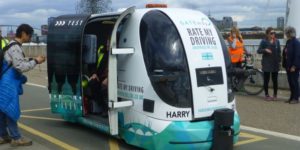 Say you live 1.3 miles from a subway station or a bus route that would offer you direct access to your job. Then picture an autonomous vehicle looping through your neighborhood every 20 minutes or so to take you and your neighbors straight to that access point.
Say you live 1.3 miles from a subway station or a bus route that would offer you direct access to your job. Then picture an autonomous vehicle looping through your neighborhood every 20 minutes or so to take you and your neighbors straight to that access point.
All of a sudden, you would be pretty psyched to use transit – something you’ve never even really considered using between home and work before – wouldn’t you?
These kinds of mode-choice questions and scenarios are the bailiwick of transportation demand management professionals. Understanding people’s transportation choices is a crucial aspect of the coming revolution in autonomous vehicles.
Serious questions must be asked about the often rosy projections of AV market penetration, vehicle occupancy, and effects on transit and other systems. As I’ve written before, car and tech companies should do a good job of ensuring that safety and tech issues are covered before AVs roll out en masse, but who will watch out for the societal factors?
This is a perfect spot for leading thinkers in the TDM community to step forward and help:
- Ensure the establishment of fleets that could essentially enhance access to existing transit networks rather than encourage personalized AVs that would likely create traffic armageddon
- Avoid any kind of “Waze effect” with those fleets potentially chopping up once-peaceful neighborhoods and city blocks and turning them into new thoroughfares, like interstate highways did decades ago.
Following are a few “devil’s advocate” issues that bear more research and analysis.
- There is growing agreement that AVs will induce more trips and vehicle miles traveled (VMT). Can the potential efficiency of AVs overcome the induced trips, and where will the induced trips and the efficiency gains be located? There likely will be significant mismatches. AVs may work well on freeways and increase capacity of existing lanes, only to dump the additional vehicles onto city streets where AV operation is much more complex and cannot meet the demand. Shared AVs and AV taxis, in a sense, are the next stage of operations for companies like Uber and Lyft, and data in some areas are beginning to show that they generate more VMT without riders than with passengers. Can AVs do significantly better, given the need for repositioning, and likely empty approach trips, especially depending upon density?
- There will be a PR backlash surrounding the lost jobs or at least the shift in job skills that will be needed to fuel the new economy. Some people who drive trucks, taxis, and buses will lose their jobs, with the most recent prediction being “that machines are likely to take over 47 percent of today’s jobs within a few decades.” It will take a lot of foresight and work to train people to gain new skills, including operating the machines that will control the AVs themselves and perhaps some other customer-service-type opportunities, like, for example, placemaking ambassadors.
- Huge amounts of education will be needed for planners to adapt to tech-heavy places. Planners must focus their energies on making busy hubs walkable, human-scale, transit-oriented places. Without this shift, we will likely be addressing the same issue of congestion in the future. We’ve pretty much messed up every transportation revolution in the history of the United States; we can’t expect AVs to unfold any differently in solving a design problem.
- Huge amounts of funding will be needed to bring roads and markings up to standards that support AVs. This will likely siphon funds away from transit, increasing vehicle trips and exacerbating inequality and job access. This is more of an infrastructure problem than it is a TDM problem, but TDM can come into play by making “fast-action planning” and “innovation-harnessing policy” recommendations.
- Shared AVs with higher occupancy are a hoped-for part of the solution, but there’s no guarantee it will work that way. This scenario is essentially glorified carpooling. Experience has proven for decades that people demand convenience and time savings, which may not be achievable in medium- to low-density suburban and rural areas even with AVs. So single-occupancy vehicles (or even zero-occupancy vehicles) may be more prevalent than we want. People’s demand patterns are complex and cannot magically be accommodated even with a huge fleet of AVs, suggesting lower penetration of shared vehicles than hoped.
- Given the potential for lower penetration or slower adoption, we should be careful in extolling benefits, such as 30,000+ deaths avoided, that are based on optimistic market penetration. Car and tech companies will continue to hammer home this message, and that 90 percent of traffic crashes stem from human error, but there is a whole lot more to AV market penetration than simply this one encouraging safety message.
AVs no doubt present a very exciting concept, but all in all, they may actually increase congestion and mobility inequality. Their congestion and mobility benefits will quite likely be unevenly distributed, favoring some types of areas while disadvantaging others.
It is time for the transportation industry to examine more closely the circumstances of AV deployment. What kinds of geographic areas can feasibly benefit from AVs enough to achieve the touted levels of market penetration? And what are the attitudes of potential adopters given the possible mix of costs, time savings, density, income, and other market factors?
Photo by Simon Smiler/Flickr.
–


